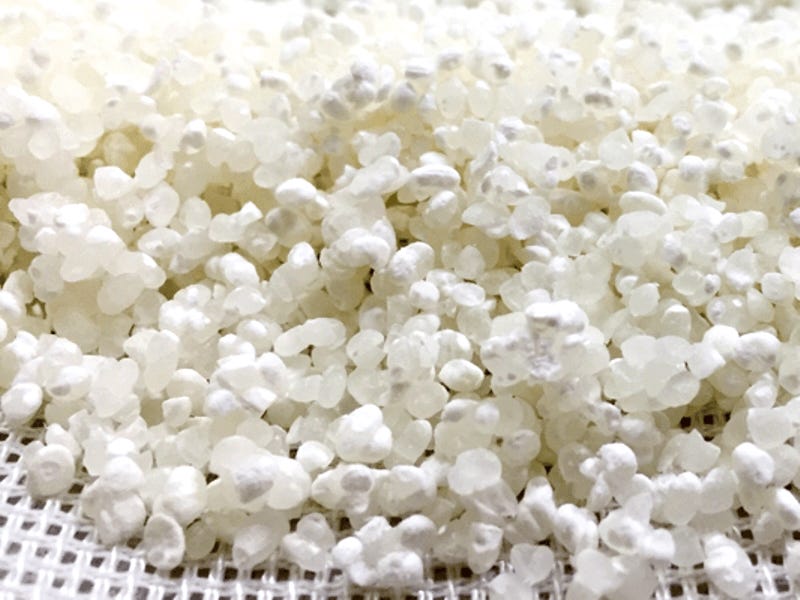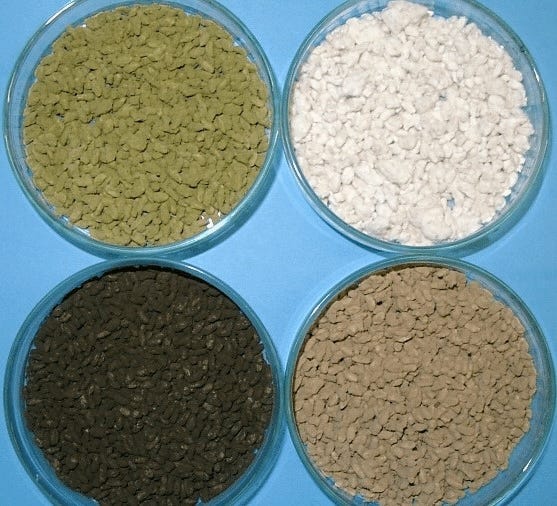Sake 101 #6: Understanding Kōji
Meet kōji—the enzyme-producing mold behind sake’s fermentation, aroma, and elegance. A guide for the wine-curious.
1. Why I’m Thinking About Kōji This Week
As I mentioned in my last post, I recently became a small investor in a sake brand called Hajimari no Sake. As part of the project, I’ve been attending monthly online seminars—twelve so far—covering not only sake production techniques but also the broader structure of the sake industry and its culture.
One session in particular left a strong impression on me.
The guest speaker was Yuichiro Murai, the CEO of a kōji production company that has been operating since the Muromachi period—around 700 years ago. He is the 29th-generation successor. His talk went far beyond the technical role of kōji in brewing. He spoke about its cultural significance, its deep roots in Japanese fermentation traditions, and the quiet power of this microorganism that works behind the scenes.
To my surprise, his company currently exports kōji to over 30 countries. Learning how this microscopic fungus, invisible to the eye, has shaped the foundation of Japanese fermented food and beverage culture was truly eye-opening.
I was so intrigued that I picked up his book, Fermentation as Cultural Knowledge: What Business Elites Should Know (original title: Kyōyō Toshite no Hakkō by Yuichiro Murai. Currently, no English translation is available.) It changed the way I think about sake—not just as a drink, but as a living system driven by skilled craftsmanship and complex microbial interactions. I didn’t just read about this—I heard it directly from Japan’s leading kōji producer in a closed seminar.
So this week, I’d like to share what I’ve learned about kōji—what it is, how it functions in sake production, and why it’s often considered the soul of sake—along with some insights from the CEO’s presentation and his book.
2. Who This Is For
Ever had a customer ask what makes sake different from wine? Here's your one-paragraph answer.
If you're a wine professional—or someone who enjoys sake but hasn’t yet taken a deep dive into how it’s made—this post is for you. Not in the trade? No problem. You’ll still enjoy the journey.
I’m Kazumi, a DipWSET wine and sake educator based in Amsterdam. With a background in both Japanese and European food cultures, I write this Sake 101 series every Tuesday to bridge the gap—translating sake into a language wine professionals can relate to.
You already understand the basics of fermentation: yeast consumes sugar and produces alcohol. But what happens when your raw material—like rice—contains no sugar at all?
That’s where kōji comes in.
3. Grape Juice vs. Rice Starch: The Fermentation Foundation
You probably know this already, but just to recap: alcoholic fermentation is what happens when yeast eats sugar and turns it into alcohol and carbon dioxide. In winemaking, it’s relatively simple. Grapes come packed with sugar, so all you need is yeast—whether you add a cultured strain or let wild yeast take over—and fermentation gets going.
Sake is a bit trickier. Rice doesn’t have sugar—it’s all starch. That means before fermentation can even start, the starch has to be turned into sugar first. Then, and only then, can yeast do its job and turn that sugar into alcohol.
To make this happen, the rice needs some careful prep. It’s soaked to boost the moisture inside the grain, then steamed—not boiled—which changes the structure of the starch and makes it easier to break down.
But here’s where sake gets really interesting. Instead of doing these two steps one after the other, sake brewers combine them. The sugar conversion and alcoholic fermentation happen at the same time, in the same tank. This process, multiple parallel fermentation, is a beautifully choreographed dance between kōji (the mold that makes the enzymes) and yeast. It’s one of the key reasons sake is so complex and layered.
4. What Is Kōji and How Does It Work? The Enzyme Engine
Kōji refers to grains that have been inoculated with a specific type of filamentous fungus called Aspergillus oryzae. This friendly mold grows on the surface of the steamed grain and produces enzymes essential for fermentation.
While kōji is central to sake, it’s also used in many other traditional Japanese fermented foods like miso, soy sauce, and mirin. Different products use different strains, and kōji is such a cultural cornerstone that it’s often referred to as Japan’s national fungus.
And here’s something interesting—kōji-like mold cultures have also been used for centuries in Korea and China, though in different styles of traditional cooking.
Fun fact: There are notable differences between fermentation cultures in Western and Asian food traditions.
Fermented foods exist around the world—think wine, beer, cheese, and sourdough in Europe. But as the author of Fermentation as Cultural Knowledge points out, Western fermentation tends to rely primarily on yeast, while many traditional Eastern foods involve both yeast and mold. This difference is largely influenced by climate. In warmer, humid regions like much of East Asia, mold-based fermentation thrives, while drier or more temperate climates have historically favored yeast-led processes.
Now, back to kōji and sake. The main reason kōji is used in brewing is that it produces enzymes which convert starch into fermentable sugars—primarily glucose—in a process known as saccharification. These enzymes also help break down proteins into amino acids, contributing umami to the final sake.
So while kōji doesn’t ferment anything directly, it plays a foundational role by creating the conditions yeast needs to work. You could say kōji sets the table, and yeast comes in to feast.
Controlling kōji growth is an art in itself. Brewers carefully manage temperature, humidity, and the distribution of kōji mold spores to ensure that just the right amount of mold grows on each grain—enough to be effective, but not so much that it overwhelms the sake’s balance. Once this enzymatic groundwork is laid, yeast takes over and ferments the glucose into alcohol.
If you think of yeast or malolactic bacteria as transformative agents in wine, kōji plays a similarly invisible but essential role in sake. Without kōji, rice would remain just rice.
5. Kōji’s Style Impact: Color, Aroma, Texture, Umami
Kōji isn’t neutral—it leaves its mark on sake, influencing both style and quality. It contributes directly to color, aroma, flavor, and texture, and also plays an indirect role by providing nutrients for yeast.
For example, flavins—yellow pigment compounds that include riboflavin (vitamin B₂)—can affect the color of sake, especially under light exposure. Amino acids produced by the kōji mold serve as essential nutrients during fermentation, and also contribute umami to the final flavor profile. Kōji can also generate subtle aroma compounds—roasted chestnut, in particular, is often cited. It even has an impact on the perceived acidity of the sake.
There are three main types of kōji mold:
Yellow kōji (A. oryzae) – Used in sake. Delicate, elegant, and highly sensitive to conditions.
White kōji (A. kawachii) – Common in shochu. Produces higher levels of citric acid.
Black kōji (A. luchuensis) – Used in awamori. Known for earthy character and intense acidity.
Sake relies almost entirely on yellow kōji—the most expressive, but also the most fragile. However, some brewers have started to experiment with white and black kōji, especially to create sake with higher acidity. In some cases, these experimental sakes can resemble the structure and balance of wine more than traditional sake.
According to the author of Fermentation as Cultural Knowledge, there are currently six kōji-making companies remaining in Japan. Some of them trace their origins back over 700 years—an unbroken legacy of craftsmanship and microbial mastery.
6. Final Thought: The Soul Behind the Science
Kōji is more than a fermentation tool—it’s the soul of sake.
It doesn’t make alcohol directly, but it creates the conditions for everything else to happen. It transforms steamed rice into a flavorful, aromatic, umami-rich drink through invisible enzymatic work. It connects ancient techniques with modern brewing. And it silently shapes every layer of what we taste in the glass.
In 2024, kōji’s cultural role was officially recognized when UNESCO added the traditional knowledge and skills of sake-making with kōji mold in Japan to its list of Intangible Cultural Heritage. This wasn't just a nod to a brewing technique—it was an acknowledgment of kōji’s role in shaping communities, preserving regional identities, and passing down craftsmanship through centuries.
As a wine professional, I used to think fermentation meant yeast and sugar. But learning about kōji opened up a whole new layer of appreciation—for sake, for microbial ecosystems, and for the cultural depth behind every bottle.
So next time you enjoy a glass of sake, pause for a moment. Behind the clean, clear liquid is a quiet organism doing extraordinary work. Without kōji, there is no sake. And now, thanks to centuries of dedication and a little UNESCO recognition, more of the world is beginning to understand why.
This post is part of my *Tuesday Sake 101* series, where I explore the foundations of sake through a wine-savvy lens. It pairs with my *Friday pairing* series, where I share unexpected food & wine (or sake) combinations from across Asia and beyond.
In the next topic, we’ll break down how different yeast strains influence aroma and structure, and how to confidently describe them to customers.
👉Ready to talk sake like you talk wine?
**Subscribe now and join a growing circle of curious professionals—one glass at a time.** 🍶
👉Are you a fellow Substack writer exploring food, drink, or fermentation?
**If this kind of content resonates with you or your audience, I’d be honored to be included in your recommendations. I regularly check out the writers who inspire me too—let’s help more curious readers discover great work.
Thanks for reading *Pairing the World: Wine, Sake, and More!*
If you find my work valuable, please consider subscribing for free below. 🍶🍷
📅 *Note:* I’ll be away next week for an intensive wine education trip—so there will be no post this Friday or next Tuesday. See you the week after!
日本語で読みたい方へ(このポストは、日本(語)に馴染みの少ない英語を使うワインプロ及びワイン愛好家に向けて書いており、日本語は、AIを使って翻訳しています。)
酵母がワインを作るなら、日本酒は何が作る?
発酵、香り、そして繊細な味わいの背景にある、日本酒の“酵素を生み出すカビ”=麹。その奥深い役割を、日本の外でワインに親しむ皆さんへ解説します!
1. なぜ今「麹」について考えているのか?
前回の投稿でも触れましたが、昨年「はじまりの酒」という日本酒ブランドに少額ながら投資しました。そのプロジェクトの一環として、毎月オンラインで講義を受けています。これまでに12回参加し、日本酒の造り方だけでなく、酒造業界の構造や文化的背景についても学んできました。
なかでも、特に心に残った回がありました。
ゲスト講師として登壇したのは、室町時代から約700年続く麹製造会社 糀屋三左衛門の29代目当主、株式会社ビオック代表の村井裕一郎さん。講義では、麹の技術的な役割を超えて、その文化的意義や日本の発酵文化における深い歴史、そして“見えない存在”である微生物の力について語ってくれました。
驚いたのは、その会社が現在、麹を30か国以上に輸出しているという事実。目には見えないこのカビが、日本の発酵文化や食文化の土台を形作ってきたという話は、まさに目から鱗でした。
講義後、村井さんが執筆した『ビジネスエリートが知っている教養としての発酵』という本を手に取りました(英語訳は現時点では未出版です)。その本は私に、日本酒を「単に美味しい飲み物」ではなく、熟練の技術と微生物が織りなす“生きたシステム”として捉える、新しい視点を与えてくれました。
今週は、その麹について私が学んだこと—麹とは何か、日本酒の中でどのように機能しているのか、なぜ「日本酒の魂」とも呼ばれるのか—を、WSETで培った知識、村井さんの講義と著書の内容も交えながらご紹介します。
2. 誰に向けた投稿か?
「日本酒とワインの違いって何?」お客様にそう聞かれたことはありませんか? そんな方に向けた、1つの記事で語れる一つの答えがここにあります。
ワイン業界に携わっている方や、日本酒を楽しんではいるけれどその造り方について深く学んだことがない方にこそ読んでいただきたい内容です。プロでなくても大丈夫。学びの旅を楽しんでいただけると思います。
アムステルダムを拠点に活動するDipWSET保持のワイン&日本酒講師をしている和美です。日本とヨーロッパの食文化の両方にバックグラウンドを持ち、この「Sake 101」シリーズを毎週火曜日にお届けしています。ワインの言葉で日本酒を語れるようになるための架け橋となることを目指しています。
発酵の基本—酵母が糖を食べてアルコールを生み出す—については、皆さんご存知ですよね。でも、原料となる米に糖が含まれていなかったらどうなるでしょう?
そこに登場するのが、麹です。
3. ぶどうジュース vs 米のデンプン:発酵の土台の違い
ご存じの方も多いと思いますが、アルコール発酵とは、酵母が糖を食べてアルコールと二酸化炭素に変換する自然な生物学的プロセスです。
ワイン造りではとてもシンプル。ぶどうジュースにはもともと糖が含まれているので、酵母(培養酵母でも自然酵母でも)を加えると発酵が始まります。
日本酒造りは少し複雑です。米には糖が含まれていないので、まずデンプンを糖に変換しなければなりません。糖ができて初めて、酵母がその糖をアルコールに変えることができます。
この変換を可能にするために、米は慎重に準備。まず水に浸して内部の水分量を高め、次に蒸すことでデンプンの構造を変化させ、酵素が作用しやすい状態にします。
そして日本酒がユニークなのは、この糖化とアルコール発酵を同時に行う点。これを「並行複発酵」と呼びます。麹(酵素をつくるカビ)と酵母の美しい連携プレーが、複雑で奥行きのある味わいを生み出しているのです。
4. 麹とは何か?そしてその仕組み:酵素のエンジン
麹とは、米や大豆などの穀物に「Aspergillus oryzae(アスペルギルス・オリゼー)」という糸状菌を植え付けて育てたもの。この友好的なカビは、蒸した穀物の表面で育ち、発酵に不可欠な酵素をつくり出します。
麹は日本酒だけでなく、味噌、醤油、みりんなど、他の伝統的な発酵食品にも広く使われています。製品によって異なる菌株が用いられ、その文化的重要性から「国菌」と呼ばれています。
興味深いことに、麹に似たカビ文化は韓国や中国にも古くから存在しており、それぞれ独自の食文化の中で育まれてきました。
豆知識:西洋と東洋では、発酵文化の発展に違い。
ワイン、ビール、チーズ、サワードウなど、発酵食品は世界中にありますが、村井さんによれば、西洋の発酵文化は主に酵母に頼るのに対し、東洋では酵母とカビの両方を活用するのが特徴です。この違いは、気候による影響が大きいとされ、東アジアの高温多湿な地域ではカビが活躍しやすく、乾燥した気候の地域では酵母が優勢になる傾向があるそう。
さて、麹と日本酒に話を戻します。
日本酒造りにおいて麹が使われる主な理由は、デンプンを糖に分解する「酵素」を生み出すためです。この工程は「糖化(saccharification)」と呼ばれます。さらに麹は、たんぱく質をアミノ酸に分解する酵素も生成し、これが日本酒の旨みにつながります。
つまり麹自体が発酵を行うわけではありませんが、酵母が働くための環境を整えるという、極めて重要な役割を果たしています。
麹の生育には、温度や湿度、胞子の量などの緻密な管理が必要で、各粒にちょうど良い量のカビを育てるため、職人の技術がものをいいます。この麹によってデンプンが糖に分解されると、いよいよ酵母が登場し、アルコールを生成していきます。
ワインで酵母やマロラクティック発酵の乳酸菌が「味わいを変える存在」だとすれば、日本酒における麹は、それに匹敵するほどの“見えない立役者”なのです。
麹がなければ、米はただの米のまま。
5. 麹が与えるスタイルの違い:色・香り・食感・旨味
麹は“中立的な存在”ではなく、日本酒のスタイルや品質に大きな影響を与えます。色・香り・味わい・テクスチャーに直接的な影響を及ぼすほか、酵母の栄養源となる成分も提供します。たとえば、リボフラビン(ビタミンB₂)などを含む黄色色素「フラビン類」は、特に光にさらされたときに日本酒の色に影響を与えることがあります。さらに、麹が生成するアミノ酸は発酵中の酵母の栄養源となり、最終的な旨味にも寄与します。
香りの面では、たとえば「焼き栗」のような香ばしい香り分子が生成されることも。また、麹の働きによって酸の感じ方にも違いが出ると言われています。
麹には大きく分けて3種類の菌があり、それぞれに特徴があります:
黄麹(A. oryzae):日本酒に使われる。繊細で優美だが扱いが難しい。
白麹(A. kawachii):主に焼酎用。クエン酸を多く生成する。
黒麹(A. luchuensis):泡盛などに使用。土っぽく酸の強い酒になる。
日本酒造りでは、主に黄麹が使われています。これは最も表現力が豊かである一方で、扱いが難しく、非常に繊細です。
ただし最近では、酸のレベルを高めるために白麹や黒麹を使った実験的な日本酒もあります。なかには、構造や酸味のバランスがワインに近い味わいになるものもあるのです。
現在、日本に残る主な麹メーカーはわずか6社ほどだそうです。そのなかには、700年以上の歴史を持つ会社も存在し、まさに「職人技と微生物の継承」と言えます。
6. 最後に:科学を超えた「魂」
麹は単なる発酵の道具ではなく、は「日本酒の魂」だと思います。
自らアルコールをつくることはありませんが、すべての準備を整え、他の微生物が働ける土台を築く。それが麹の役割。蒸した米を、香り高く旨味のある飲み物へと変えるその働きは、目に見えない酵素の世界がつくり出す魔法。伝統と革新をつなぎ、今も静かに私たちの味覚の記憶を形作っています。
2024年、ユネスコは「日本の麹を使った酒造りの伝統的な知識と技術」を無形文化遺産に登録しました。それは単なる技法への敬意ではなく、地域文化や継承、そして人と人をつなぐ力としての麹の存在を認めたことでもあります。
ワインを学んでいた私はかつて、発酵といえば「酵母と糖」と思っていました。
でも麹と日本酒を学んでからは、発酵を新たな目で見るようになりました。
微生物のネットワーク、職人の知恵、そして文化の厚み。日本酒という一杯の中に、それらすべてが詰まっていると実感しています。
だから次に日本酒を飲むときは、ぜひ少しだけ立ち止まってみてください。
その澄んだ液体の奥に、“静かなる働き者”がいることを、きっと思い出してみて下さい。
麹なくして、日本酒なし。
そして今、何百年もの職人たちの手仕事と、ユネスコのお墨付きによって、その価値が世界に広まりつつあります。
この投稿は、ワインの視点から日本酒を学ぶ「Tuesday Sake 101」シリーズの一部です。毎週金曜日には、アジア料理とワイン/日本酒の意外なペアリングを紹介するシリーズも更新中です。
次回は、メロンやバナナのようなフルーティーな香りがどこから来るのか?酵母による香りと構造の違い、そしてそれをどう説明すればいいのかを掘り下げていきます。
読んでくださってありがとうございます!
「Pairing the World: Wine, Sake, and More!」は、ワインと日本酒の世界をつなぐブログです。購読は無料ですので、ぜひ下記のボタンから購読して下さい。🍶🍷
「日本酒やワインの魅力を、自分の言葉で伝えられるようになりたい、日本と海外の架け橋になりたい」そう考えて、英語で丁寧に書いています。この取り組みが、日本酒に関わる方々にとって「応援したくなる活動」だと感じていただけたら幸いです。
📅 お知らせ:来週はワイン集中研修のため、金曜・火曜ともに更新をお休みします。再来週にまたお会いしましょう!






Sounds like a trick question 😂